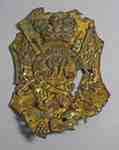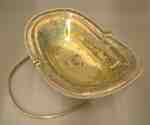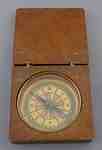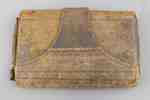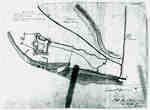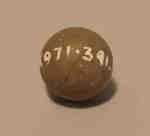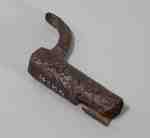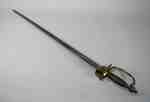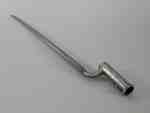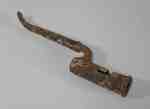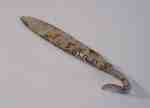Results
- The "Palladium" has articles regarding the ensuing War of 1812 and reports of the need to consult the citizens of Boston. As well, there is a report that the businesses of Boston do not want the warThe "Palladium" has articles regarding the ensuing War of 1812 and reports …
- This is an officer’s gold plated shako plate. The design shows the Royal cipher surmounted by a crown and encircled by a belt that has “ROYAL REG. OF ARTILLERY” inscribed on it. This plate was foundThis is an officer’s gold plated shako plate. The design shows the …
- This plume with red and white feathers and a wooden base would have been placed on a soldier’s shako. It is believed to have belonged to William Smith who was in the 1st Regiment of the Lincoln MilitThis plume with red and white feathers and a wooden base would …
- This oval-shaped silver serving basket with a movable handle features an engraving on the inside that reads "This basket was taken from General Porter's tent in the War of 1812-14 and was given withThis oval-shaped silver serving basket with a movable handle features an engraving …
- This brass key was for the Powder Magazine for the Tower of Fort Mississauga in Niagara, dated 1816. Fort Mississauga was built between 1814 and 1816 to replace Fort George as the key fort against thThis brass key was for the Powder Magazine for the Tower of …
- This compass, circa 1812-1814, is said to have been carried by an American soldier on the Niagara front during the War of 1812. It is enclosed in a wooden case with a flat lid that is attached with lThis compass, circa 1812-1814, is said to have been carried by an …
- Made of brown leather, this typical early 19th century wallet has a tongue flap to close the wallet and opens flat for access to the two compartments. Brown pebble finish leather, inside pockets andMade of brown leather, this typical early 19th century wallet has a …
- This button likely belonged to a member of the 100th Regiment. This regiment, also known as the Prince Regiment of Dublin County, which was raised in 1805. With few exceptions, all the officers and mThis button likely belonged to a member of the 100th Regiment. This …
- This photograph of a plan is titled “Part of the Military Reserve” and is dated in Quebec, April 8th, 1810. It was obtained by the Museum from the “National Archives of Canada, Cartographic and ArchiThis photograph of a plan is titled “Part of the Military Reserve” …
- Original donated and identified as a clay musket ball with a circumference of 5cm. It is highly doubtful that such an item would ever be used effectively as a musket ball and is more likely a marbleOriginal donated and identified as a clay musket ball with a circumference …
- This is a bayonet socket with a small portion of the blade attached that was discovered in the Niagara River. A bayonet is a steel blade that is designed to fit on the muzzle of a rifle or musket barThis is a bayonet socket with a small portion of the blade …
- This bayonet, dated 1812-1814, has triangular blade. It was recovered from the Niagara River in 1980.This bayonet, dated 1812-1814, has triangular blade. It was recovered from the …
- This is a lock mechanism measuring 17.7 cm x 3.1 cm, that was made for a tower musket. This lock mechanism was converted to percussion. There are four perforations and markings include “Tower”, a triThis is a lock mechanism measuring 17.7 cm x 3.1 cm, that …
- This is an iron lock mechanism measuring 13.9 cm x 2.5 cm x 3.1cm that is a flintlock from a military pistol. There are seven perforations and markings include “1812”, “2”, and a rampant lion presentThis is an iron lock mechanism measuring 13.9 cm x 2.5 cm …
- This sword is a 1796 Pattern officer field sword. The guard is hinged and the blade has decorative sketches on it. It is believed to have belonged to an officer in the British troops. On the upper edThis sword is a 1796 Pattern officer field sword. The guard is …
- This triangular bayonet is dated circa 1812 and has the distinctive markings “S. Chambers” and “46 (Crown)” on the blade. A bayonet was designed to fit on the muzzle of a rifle or musket barrel, makiThis triangular bayonet is dated circa 1812 and has the distinctive markings …
- This bayonet would have been designed to fit on the muzzle of a rifle or musket barrel, making it into a close range weapon. There is an inscription near the socket that reads “US, F.B.” A bayonet woThis bayonet would have been designed to fit on the muzzle of …
- This is a portion of a bayonet that would have been designed to fit on the muzzle of a rifle or musket barrel, making it into a close range weapon. The socket is complete and the blade has been bent.This is a portion of a bayonet that would have been designed …
- This is a portion of a bayonet that would have been designed to fit on the muzzle of a rifle or musket barrel, making it into a close range weapon. The socket is complete. However, approximately 2/3This is a portion of a bayonet that would have been designed …
- This is a portion of a triangular bayonet that would have been designed to fit on the muzzle of a rifle or musket barrel, making it into a close range weapon. This would have been on arguably every sThis is a portion of a triangular bayonet that would have been …







